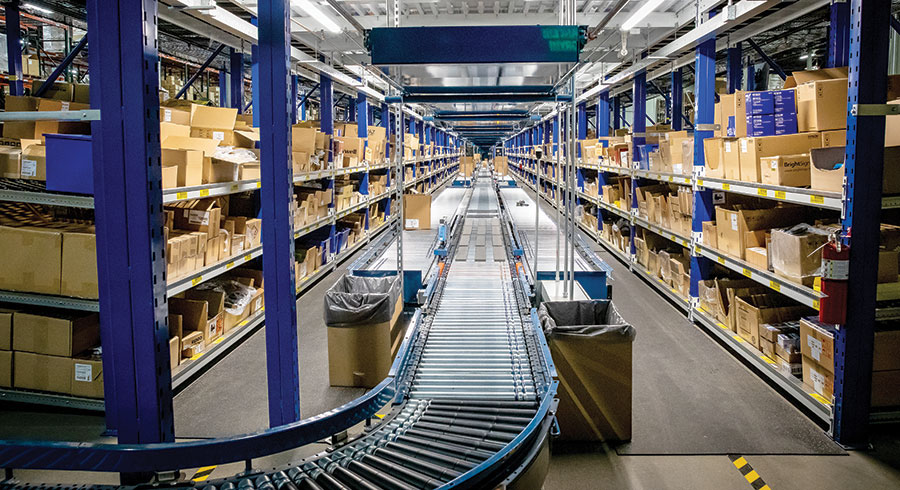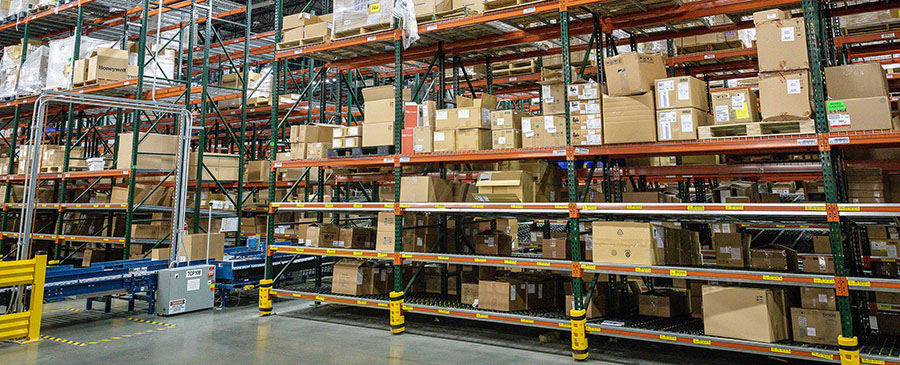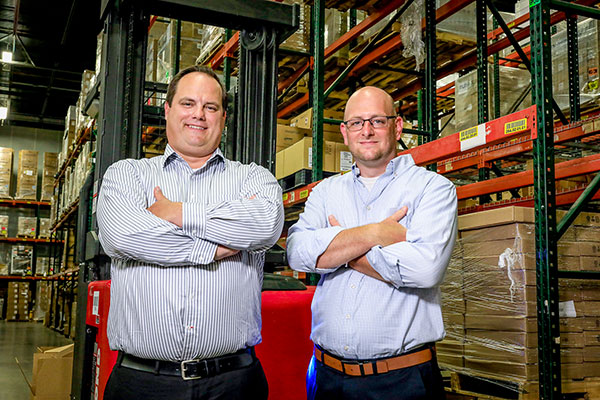BlueStar’s Leap Forward
Multinational distribution firm shares how its ERP/WMS integration helped to streamline its quick-turnaround fulfillment process, reduce human touches on every order and create an exceptional workplace for its employees.
As warehouse and distribution center (DC) operators implement more technology to streamline and automate their facilities, the inefficiencies associated with manual, traditional methods become increasingly apparent. That’s exactly what happened to one international distributor whose team members were spending too much time and effort getting thousands of orders out the door every day.
“We were watching the number of steps that team members were taking daily in the warehouse,” says Doug Bivins, COO at BlueStar. “They were all working extremely hard to get anywhere from 3,500 order to 4,000+ orders out the door in a day. We knew there had to be a more efficient way to get the job done.”
A labor-intensive process
With U.S. headquarters in Hebron, Ken., BlueStar is a global distributor of solutions-based digital identification, mobility, point of sale (POS), RFID, digital signage, and security technology. The company works exclusively with value-added resellers, providing them with complete solutions, business development, and marketing support.
At the time of its management team’s epiphany, BlueStar was using an on-premise enterprise resource planning (ERP) that was installed in the early-2000s. The ERP included a mobile supply chain application that managed some tasks, but it lacked robust warehouse management capabilities. “It was very labor-intensive,” Mike Frederick, vice president of operations explains. “We were picking products for the ERP and then using ProShip for packing and shipping.”
Because the two systems weren’t integrated, orders had to be “handed off” between the ERP and ProShip’s multi-carrier shipping software. “Because of this, at least two people had to touch every order,” says Frederick.
“The biggest eye-opener was that we previously had employees who were traveling the warehouse and taking a box to a pick location,” adds Dan Brewer, operations manager. “Now, our employees are in a pick location, where a conveyor system brings a box to them.”
The ERP also lacked statistical reporting capabilities at a time when BlueStar wanted better visibility over its fulfillment rates and exactly how many touches were required to get an order picked, packed, and out the door. “We lacked good benchmarking on the reporting side in terms of who was doing what on any given day,” says Frederick. “We wanted a solution that could help us in these areas.”
Taking care of the team
What started out as a small distribution business in the early-1990s has since grown into a multinational corporation that has been posting double-digit growth over the last two decades. Maintaining those growth levels became more difficult as the company expanded—yet another reason for it to seek out a more automated, efficient fulfillment approach.
“We knew that if we could implement some automation and find some efficiencies we could not only remain competitive, but we could also be more profitable,” Bivins explains, “and continue to take care of the team that shows up every day, works hard, and takes care of us.”
That last point is particularly important for BlueStar, which operates in a region where warehouse and logistics talent is hard to come by and highly coveted. “Our area of Northern Kentucky is a very competitive location for warehouse and logistics,” says Frederick. “We still we have to fight the good fight every day to keep good people onboard.”
Harnessing two-step distribution
To get products to its customers, BlueStar utilizes a two-step distribution process. Representing major manufacturers like Honeywell and Zebra, it sells directly to a group of value-added resellers (VARs) that, in turn, sell to the end customers.
BlueStar’s inbound logistics network includes products coming to Kentucky from the West Coast via full truckload. Those products are then warehoused, with the majority being drop-shipped to the VARs’ end customers via parcel/small package carrier. The lion’s share of those orders arrive late in the day and must be turned back around by the predetermined cutoff times.
“We bring in thousands of customer orders, and then turn around and ship them back out same day,” says Frederick, who sees this methodology as one of BlueStar’s competitive advantages. “We’ve tried to lead the industry by being a same-day shipper. That’s created some challenges over the years, and yet another reason why we had to automate.”

In Bluestar’s warehouse, a conveyor system brings boxes directly to employee pick stations.
Making the choice
From its new warehouse management system (WMS), BlueStar wanted to be able to reduce (or eliminate) the need for manual intervention; streamline its picking, packing, and shipping processes; and gain access to better reporting.
Familiar with FASCOR’s supply chain execution (SCE) software offerings, the distributor’s management team started talking to other companies about how they were using approaches like “pick by zone”—whereby the WMS identifies a product’s location, shows current inventory, and tells the operator how many to pick. By switching over to this method, BlueStar was confident that it would be able to improve its efficiencies in the warehouse.
“Our existing, manual processes are already very accurate,” says Bivins, “but we knew they would improve more with the addition of a WMS.” The company was also seeking a more efficient way to hit its afternoon shipping cutoff times using its preferred small-package carrier FedEx.
After talking to several other warehouse operators about their own automation journeys, BlueStar’s management team got to see the “pick-to-box” process in action. “We thought that was a genius idea,” says Frederick, who especially liked how the company had the volume metrics for all of the items it was shipping and, as a result, knew exactly what size box to ship orders in.
“Having all of that information upfront versus having an employee do a manual pack-out and pick the box was a big selling point for us,” says Frederick. “So much so that, when we went about selecting a WMS, that became a must-have.”
Just one touch
In place since 2019, BlueStar’s FASCOR WMS platform has helped the distribution company gain major efficiencies in its fulfillment operations, significantly reduce the number of touches required for each order, and gain better visibility into its operational metrics.
On the human resources side, the WMS has helped create a more productive, engaging work environment that’s not centered on repetitive tasks and rework.
“We’re picking a product directly to a box, so just one person is touching that order,” Frederick explains. “In addition, we have a WMS that routes orders, does warehouse mapping, and handles other functions.” Integrated directly into BlueStar’s existing ERP, the platform drops all of the necessary information back into that central system for the distributor’s finance, marketing, sales and other departments to utilize.
Bivins says the company is now working with FASCOR to set up more reporting and benchmarking that it can use to identify areas in need of improvement and to even further improve efficiency levels.

The global distributor of solutions-based digital identification, mobility, POS and other technology gets anywhere from 3,500 to 4,000+ orders out the door per day.
Endless possibilities
When it came to integrating a modern WMS with its existing ERP, Bivins says the decision was a “no-brainer” because without it, BlueStar could have been in danger of falling behind the automation curve in its industry.
“We either had to move to a WMS or leave the door open for other companies to enter our market,” says Bivins, who adds that while the implementation process took some time and patience to endure, the end result exceeded BlueStar’s initial expectations. “Once we were up and running with the WMS and we had control of the system,” he adds, “it was as if we took a 10-year leap forward.”
In mid-2019, BlueStar found itself managing an overtaxed staff that was working a lot of overtime hours in order to keep up with the company’s growing order volume. From Frederick’s vantage point as vice president of operations, he could see that the long hours were taking a toll on his warehouse employees. By the fall of 2019, that scenario had changed noticeably.
Frederick credits the WMS with driving much of that positive cultural change. “Our ‘before’ picture was interfering with work-life balance for some of our employees,” Frederick points out. “Now that we have a system in place, we’re not only getting things done in a timelier manner, but we’ve also dramatically cut down on the overtime. As a result, we’ve created a better work-life balance for our employees and have been able to retain really good people.”
Brewer adds that BlueStar is now in the early stages of leveraging a system that will scale up as the company continues to grow and expand in the coming years.
“We were at the ceiling of our capabilities with our ERP, and now we’re just at the tip of the iceberg with our new WMS,” says Brewer. “It’s really refreshing for all of us to be able to go from being at wit’s end, to ‘the possibilities are endless.’” •

Article Topics
Warehouse News & Resources
Supply Chain Management Software: Build the foundation, deliver the value Ryder opens up El Paso-based multi-client facility logistics facility Equipment batteries get a jolt April manufacturing output takes a step back after growing in March Show Review: Looking back at MODEX 2024 2024 Technology Roundtable: Tools to manage the new complexity The Ultimate WMS Checklist: Find the Perfect Fit More WarehouseLatest in Logistics
Pitt Ohio exec warns Congress to go slow on truck electrification mandates Q1 intermodal volumes are up for second straight quarter, reports IANA Supply Chain Management Software: Build the foundation, deliver the value 2024 State of Freight Forwarders: What’s next is happening now Ryder opens up El Paso-based multi-client facility logistics facility Autonomous mobile robots (AMRs) on a mission to automate Equipment batteries get a jolt More LogisticsAbout the Author
Subscribe to Logistics Management Magazine

Find out what the world's most innovative companies are doing to improve productivity in their plants and distribution centers.
Start your FREE subscription today.
April 2023 Logistics Management

Latest Resources
















